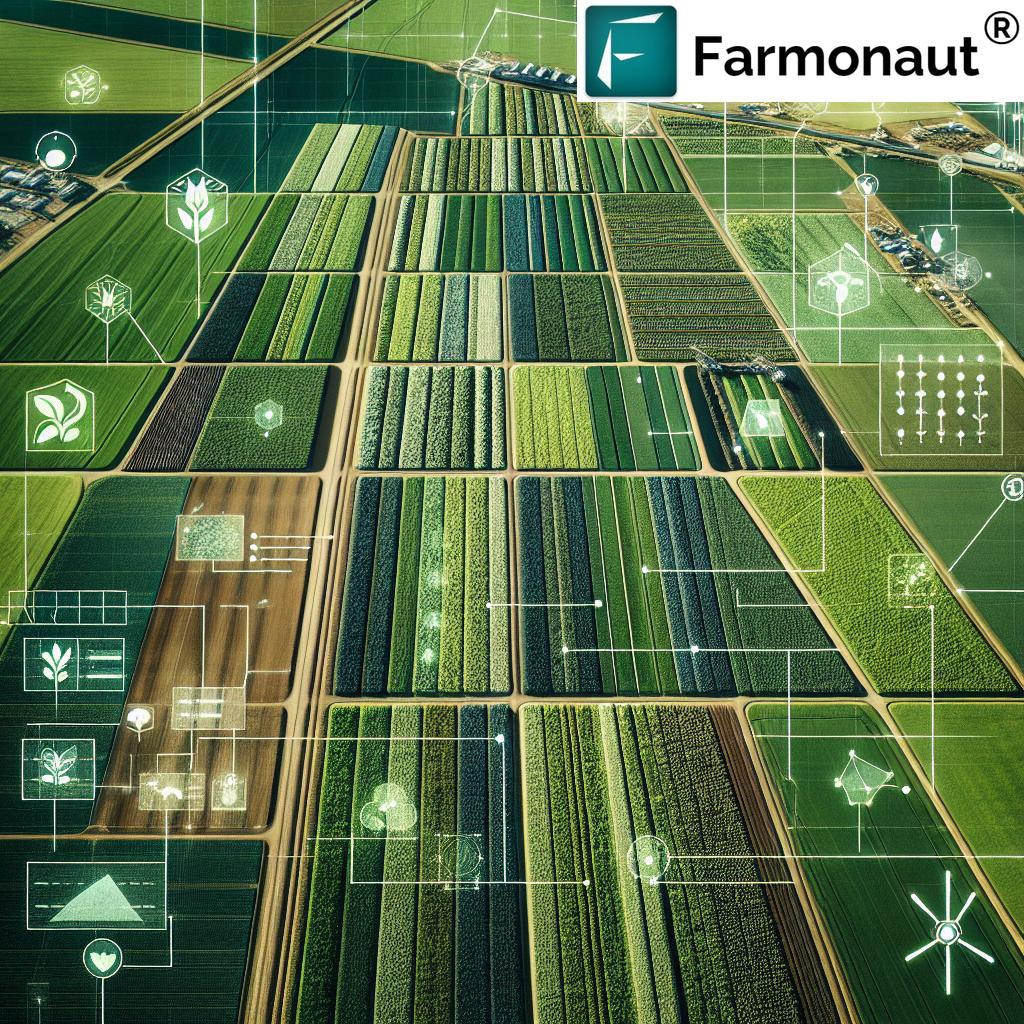7 Agricultural Solutions to Skyrocket Your Farm’s Success
Agriculture, the backbone of our civilization, stands at the intersection of tradition and innovation. As the global population soars past eight billion, we face the dual challenge of increasing food production and nurturing our environment. Fortunately, new agricultural solutions like sustainable agriculture, precision agriculture technology, and regenerative farming practices are transforming how we care for our soil, raise our crops, and increase our farm productivity. In this comprehensive guide, we will explore seven cutting-edge solutions that can help every farmer, agribusiness, and decision-maker make our farms more sustainable, efficient, and resilient.
Table of Contents
- Introduction: The Future of Agricultural Solutions
- 1. Agroforestry: Integrating Trees and Crops for Enhanced Biodiversity
- 2. Precision Agriculture: Leveraging Technology and Data for Greater Efficiency
- 3. Regenerative Agriculture: Restoring Soil Health and Building Resilient Farms
- 4. Digital Agriculture: Smart Data-Driven Farming Decisions
- 5. Carbon Footprinting & Climate Impact Management
- 6. Blockchain-Based Product Traceability for Transparent Supply Chains
- 7. Fleet & Resource Management: Optimizing Machines and Personnel
- Comparative Benefits Table: Agricultural Solutions Side-by-Side
- How Farmonaut Empowers Modern Farmers
- Frequently Asked Questions
- Conclusion: Embracing the Future of Sustainable Agriculture
Introduction: The Future of Agricultural Solutions
The journey of agriculture has always been about evolving our farming systems to meet humanity’s needs. In today’s world, tools and practices that combine age-old wisdom with the latest innovations in precision agriculture technology and digital agriculture solutions are reshaping how we feed the planet. We need to protect our soil, increase crop yields, prevent erosion, and boost farm efficiency—all while reducing our impact on the environment.
Below, we present seven proven solutions, from agroforestry systems to regenerative farming practices, that enable us to build resilient, productive, and environmentally friendly farms. We’ll also highlight how Farmonaut is making precision agriculture affordable, accessible, and actionable globally for everyone, from smallholder farmers to large agribusinesses.
1. Agroforestry: Integrating Trees and Crops for Enhanced Biodiversity
Agroforestry is one of the oldest, yet most innovative, agricultural solutions we can implement. By integrating trees with crops or livestock on the same land, we create multi-layered systems that improve soil health, increase yields, and promote biodiversity. All of this leads to more resilient farms that can withstand extreme weather and climate change.
Key Benefits of Agroforestry Systems:
- Protecting Soil and Preventing Erosion: Deep tree roots stabilize the soil, significantly reducing runoff and soil erosion.
- Increasing Farm Productivity: Trees provide windbreaks (reducing damage and evaporation), shade for livestock, and extra outputs—timber, fruits, nuts, etc.
- Boosting Biodiversity: More plant/animal species thrive, creating natural pest controls and ecological balance.
- Improving Climate Impact: Trees sequester carbon, helping us mitigate climate change impacts.
Agroforestry Practices: Windbreaks, Silvopasture, Alley Cropping, & More
- Windbreaks: Rows of trees or shrubs planted on field edges can dramatically reduce wind, protect crops, and even shield livestock. Especially beneficial in arid and semi-arid regions.
- Riparian Buffers: Trees and shrubs planted along waterways filter farm runoff, protect water quality, and stabilize banks to prevent erosion.
- Silvopasture: Combining trees, forage, and livestock in the same system. Trees offer shade and shelter, enhancing livestock comfort and productivity while increasing forage output.
- Alley Cropping: Crops grown between rows of trees—maximizing land use and diversifying outputs.
When planned carefully—selecting appropriate tree species and aligning crops/livestock in a complementary pattern—agroforestry transforms farms into multi-output, sustainable agricultural systems. The result: healthier soil, increased income sources, improved climate resilience, and stronger local ecosystems.
Farmonaut Tip:
For the most effective agroforestry implementation, leverage satellite-based digital agriculture solutions, such as Farmonaut, to map and monitor the health of your fields, crops, and tree cover—optimizing the balance between all components.
2. Precision Agriculture: Leveraging Technology and Data for Greater Efficiency
The rise of precision agriculture technology is redefining how we manage individual fields, allocate resources, and respond to crop needs—enabling us to make data-driven farming decisions that enhance productivity and minimize environmental impact.
Core Tools & Techniques in Precision Agriculture
- GPS Field Mapping: High-resolution GPS allows us to geolocate plots, map variability, and deploy site-specific management down to square meters.
- Remote Sensing in Agriculture: Satellites, drones, and IoT sensors capture up-to-the-minute data on crop health, soil moisture, pest outbreaks, and growth stages.
- Variable Rate Technology (VRT): Apply fertilizers, pesticides, irrigation, and seed at variable rates, tailored to exact needs identified through data analytics.
- Machine Learning & Big Data Analytics: Vast datasets power AI-driven recommendations, forecasting outcomes, and reducing waste.
By applying inputs (fertilizer, pesticides, water) only where it’s needed—using the insights of precision agriculture—we increase yields, reduce costs, and protect our environment from unnecessary runoff and pollution.
How Farmonaut Empowers Precision Agriculture
Farmonaut delivers remote sensing in agriculture through its android, iOS, and web app platform—making precision ag tools affordable and accessible to every farmer. Get real-time crop health monitoring, AI-based advisory, and weather forecasts—all from your phone or browser. Our API and developer docs enable easy integration for agribusinesses and agri-research.
- Benefit: Doubles down on resource efficiency—using every drop of water, kilo of fertilizer, or spray of pesticide with surgical precision.
- Outcome: Higher yields, lower costs, reduced environmental footprint.
Why Adopt Precision Agriculture?
- Improve efficiency—treat every zone of your field based on its unique needs.
- Reduce input costs—no more blanket applications.
- Boost yields—optimize nutrition and growth conditions.
- Protect the environment—less runoff, reduced chemical use, more sustainable agriculture.
3. Regenerative Agriculture: Restoring Soil Health and Building Resilient Farms
A healthy soil ecosystem is the foundation of truly sustainable agriculture. Regenerative farming practices go a step beyond “not harming” the land—they focus on actively restoring soil health, cycling nutrients, and supporting vibrant ecosystems.
Pillars of Regenerative Agricultural Practices
- No-Till or Low-Till: Minimize disturbance to retain soil structure and organic matter. Less erosion, better water infiltration.
- Cover Cropping: Grow cover crops (clover, legumes, grasses) to shield the soil, boost fertility, and disrupt weed/pest cycles during fields’ “rest” periods.
- Crop Rotation: Change crops in the same field in a strategic sequence. Each crop improves the soil in its unique way, reduces disease cycles, and builds resilience.
- Composting & Mulching: Recycle organic waste into rich, microbe-friendly matter—feeding the soil food web.
Results of Regenerative Techniques:
- Improving Soil Health: Higher organic matter levels, richer biology, better fertility—leading to even higher future yields.
- Water Retention: Healthy soils act like sponges—protecting crops from drought and reducing irrigation needs.
- Increased Biodiversity: Welcoming more beneficial microbes, insects, and wildlife creates better pest control and pollination rates.
- Sequestering Carbon: Soils become carbon sinks, storing more CO2 and fighting climate change.
Transitioning to regenerative agriculture may mean adapting to new practices, such as no-till or using organic amendments—but the reward is a living, resilient, and fruitful agricultural system for years to come.
Leverage Farmonaut for Regenerative Farming Success
With Farmonaut’s satellite-based platform, “improving soil health” is not a guessing game: you can monitor organic matter, detect erosion risks, and receive real-time recommendations for rebuilding your land—all directly from our mobile/web apps.
See how satellite and AI technologies can measure soil carbon and promote climate-positive farming in our video above.
4. Digital Agriculture: Smart Data-Driven Farming Decisions
The world is moving toward digital agriculture solutions that empower farmers to collect, analyze, and act on massive amounts of agricultural data in real time. Digitization is the foundation of modern, sustainable agriculture.
Digital Agriculture Tools & Advantages
- Internet of Things (IoT): Sensors monitor soil moisture, temperature, and crop health—providing live insights that guide every activity from planting to harvest.
- Big Data Analytics: Turn thousands of data points into understandable trends—spotting yield-limiting issues before they become costly problems.
- Mobile Applications & Market Connectivity: Farmers access up-to-date advice, price trends, and best management practices, breaking the knowledge barrier.
- Equipment Sharing and Resource Management: Share or rent machinery with neighbors at a fraction of the price. Cut costs and increase access to new technologies.
Farmonaut pioneers digital agriculture with its cross-platform apps and APIs—enabling everyone to harness data for smarter planting, irrigation, disease management, and harvesting decisions. With a click, get recommendations from Jeevn AI, our AI-driven personalized advisory system, uniting your farm’s needs, real-time weather, and global best practices in a single place.
Our digital agriculture platform doubles as a resource hub, connecting you to equipment sharing portals, farm advisory, and end-to-end traceability solutions for maximum transparency.
Big gains: Streamline farm management, improve productivity, reduce waste, and open up new markets through verifiable digital data.
5. Carbon Footprinting & Climate Impact Management
Environmental stewardship in agriculture now means measuring and reducing our carbon footprint. Tracking and actively lowering farming’s emissions helps us meet regulatory requirements and contribute to a safer climate future.
- Why it matters: Farms and food supply chains are major players in global carbon budgets.
- What’s tracked: Emissions from equipment, fertilizer use, methane from livestock, and carbon sequestration by crops and soils.
- Tools: Farmonaut’s carbon footprinting service gives live tracking, benchmarking, and actionable steps for shrinking your emissions per acre/hectare and per crop.
Advanced technologies—such as satellite monitoring and AI-based analytics—make it possible to quantify your farm’s climate impact, set improvement targets, and promote your products as environmentally responsible.
Sustainable Farming = Profitable Farming
- New market opportunities for climate-friendly, low-carbon produce
- Enhanced eligibility for green financing and insurance products (Crop Loan & Insurance verification)
- Powerful story for consumers and buyers seeking traceable, ethical food
6. Blockchain-Based Product Traceability for Transparent Supply Chains
Today’s markets and consumers demand proof: “Where does our food/fiber come from? Was it produced sustainably and fairly?” Blockchain-based traceability delivers this with unbreakable, digital transparency.
- Each step (planting, harvest, transport, storage, sale) is registered as a transparent digital record—verifiable and tamper-proof.
- Builds trust and reputation with end buyers and processors.
- Simplifies compliance with safety standards, organic certification, and fair trade requirements.
Farmonaut’s traceability solution ensures your farm’s or company’s products are traceable from seed to shelf. No more uncertainty or fraud in the supply chain.
Key impact: Unlock premium pricing, meet stringent buyer requirements, and bolster long-term sustainable agriculture markets.
7. Fleet & Resource Management: Optimizing Machines and Personnel
In large-scale and smallholder agriculture, resource efficiency is the key to survival. Fleet and resource management uses digital tools to track vehicles, equipment, and labor, eliminating wasted trips, breakdowns, or idle time. This means more productive fields and efficient energy use.
- GPS and IoT monitoring shows equipment location, operation history, and maintenance needs.
- Better planning—optimize field operations (planting, irrigation, harvest) by assigning the right resource/personnel at the right time and place.
- Lower costs and downtime by predicting breakdowns, reducing fuel use, and increasing asset utilization.
- Essential for agri-cooperatives, contractors, and any farm with multiple pieces of equipment.
The Farmonaut Fleet Management module transforms resource tracking for agribusinesses, government agencies, and individual farmers. Get full control, instant tracking, and actionable insights—right from your dashboard.
Comparative Benefits Table: Agricultural Solutions Side-by-Side
| Agricultural Solution | Description | Estimated Increase in Crop Yields (%) | Soil Health Improvement (1-5) |
Environmental Impact Rating |
|---|---|---|---|---|
| Agroforestry | Integrating trees with crops/livestock | 10-20 | 4 | High |
| Precision Agriculture | GPS, data analytics, & variable-rate applications | 10-20 | 3 | High |
| Regenerative Agriculture | No-till, cover crops, and composting | 8-15 | 5 | High |
| Digital Agriculture | IoT sensors, digital platforms, big data | 7-15 | 3 | High |
| Carbon Footprinting | Track and reduce farm emissions | 3-7 | 4 | High |
| Product Traceability | Blockchain-backed supply chain transparency | 2-5 | 2 | High |
| Fleet Management | Optimize resource/equipment usage | 3-7 | 2 | Medium |
How Farmonaut Empowers Modern Farmers
Farmonaut is at the forefront of uniting these sustainable agriculture solutions in one digital, user-friendly platform available on web, iOS, and Android apps. Our offering includes:
- Satellite-based crop health monitoring—plus AI-based advisory for informed crop management
- Carbon tracking and benchmarking (Farmonaut Carbon Footprinting)
- Blockchain-verified product traceability (see traceability)
- Fleet & resource management for operators of all scales (learn more)
- Equitable access for everyone—from smallholders to large-scale management (admin solution for large, multi-farm operations)
- Satellite-based loan and insurance verification, giving farmers faster and safer financial access (learn more)
Try Farmonaut today! Farmonaut subscriptions are available for individuals, cooperatives, agribusinesses, and government bodies by the hectare. Access your field data anytime, anywhere—with flexible pricing and support for API integrations.
Frequently Asked Questions (FAQ)
What is the best agricultural solution for improving soil health?
Regenerative agriculture offers the greatest improvement in soil health with practices like no-till farming, cover cropping, and composting. Implementing agroforestry systems also boosts soil health dramatically by reducing erosion and increasing organic matter.
How can I get started with precision agriculture?
To begin, download the Farmonaut app or explore their web platform. Farmonaut’s tools make it easy for farmers at any scale to monitor field conditions, receive AI-based crop advisory, and implement data-driven management steps without the need for costly hardware.
Can smallholder farmers use digital agriculture solutions?
Absolutely! Tools like Farmonaut democratize access through low-cost satellite monitoring and mobile apps, making it practical for small and medium-sized farms in India and globally.
How does blockchain product traceability benefit my agricultural operations?
It adds transparency, minimizes fraud, and helps you meet market, regulatory, and consumer demands. Traceability gives your buyers peace of mind and can open up new premium markets.
What is the role of fleet management in sustainable agriculture?
Digital fleet management optimizes machinery for reduced fuel use, minimized downtime, and higher field operation efficiency. This directly translates to lower costs and a lighter environmental footprint.
Is Farmonaut suitable for government agencies or large agribusinesses?
Yes, Farmonaut is scalable and offers solutions—from crop area/yield estimation to large-scale multi-farm management. Integration via APIs supports institutional needs.
Conclusion: Embracing the Future of Sustainable Agriculture
As custodians of our fields, soil, and food systems, it is up to us to embrace agricultural solutions that nurture both productivity and the environment. By adopting practices such as agroforestry, precision agriculture, regenerative farming, digital agriculture, Carbon Footprinting, Blockchain Traceability, and Fleet Management, we equip ourselves for sustainable growth and resilience in an uncertain climate.
Technologies from Farmonaut bridge the gap between time-tested wisdom and next-generation data-driven farming. Affordable, accessible, and actionable tools mean all farmers—regardless of farm size or location—can now skyrocket their farm’s success and steward our shared planet for generations to come.
Get started by registering your fields in the Farmonaut system today, and join the global movement transforming agriculture for good.














